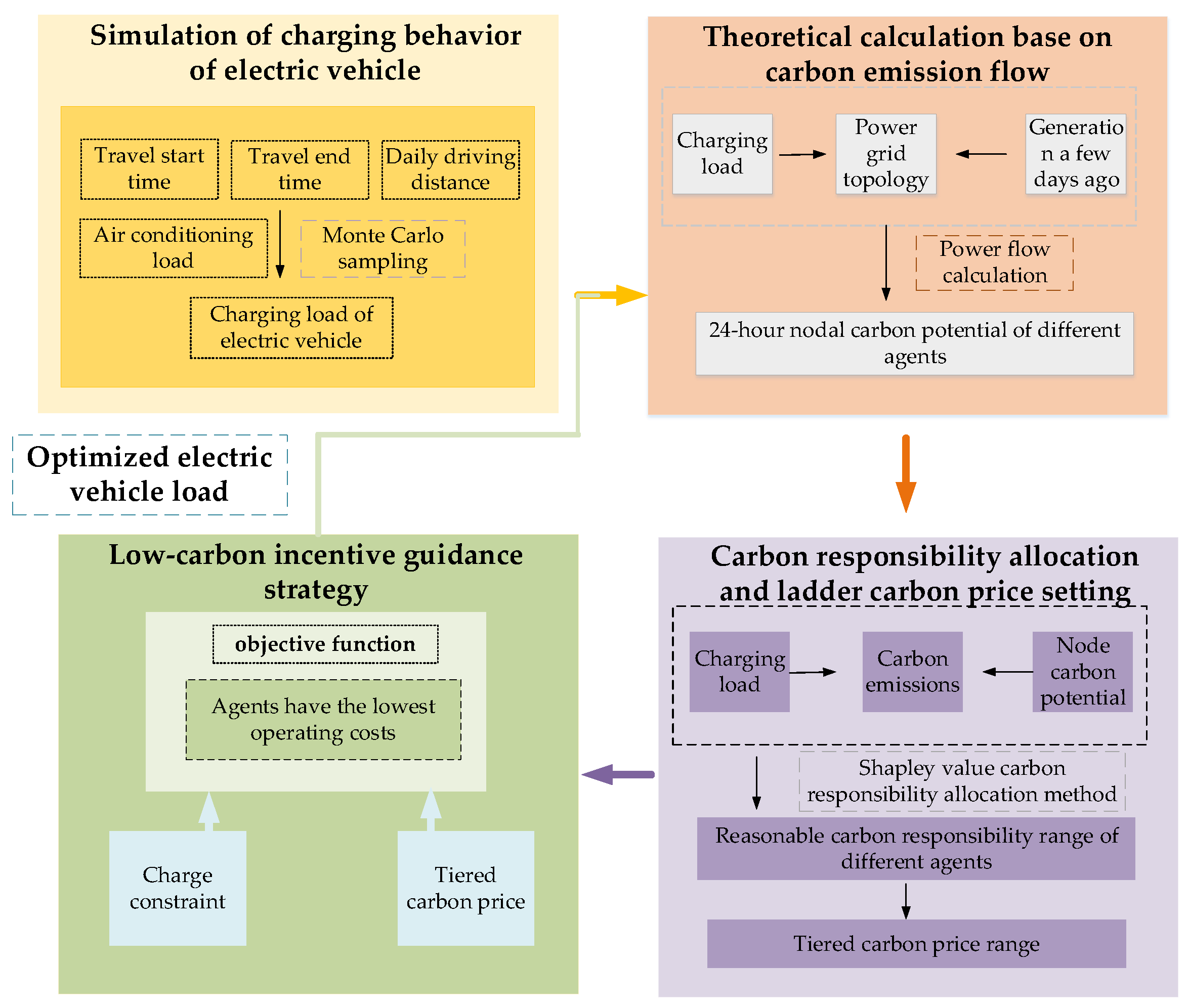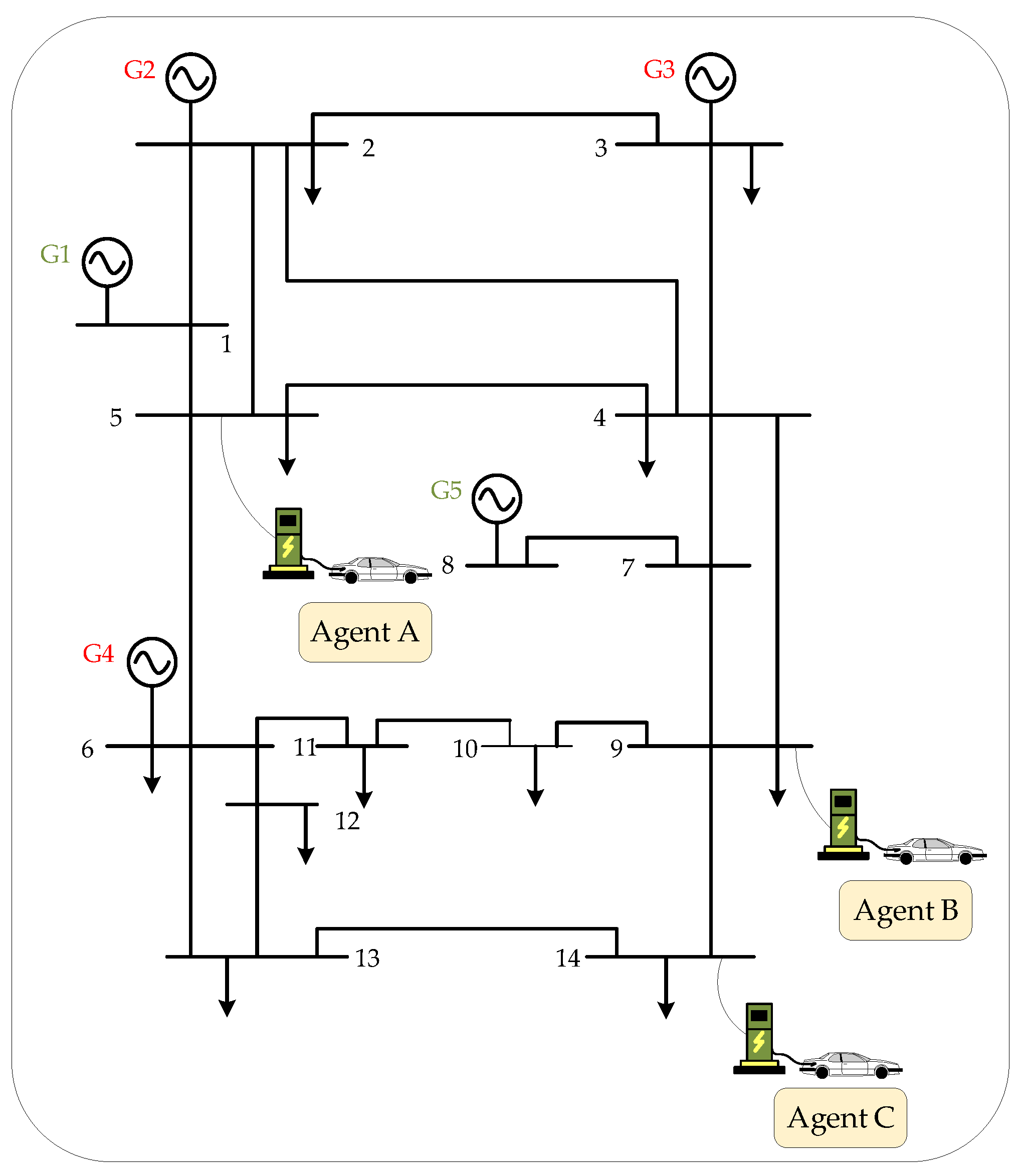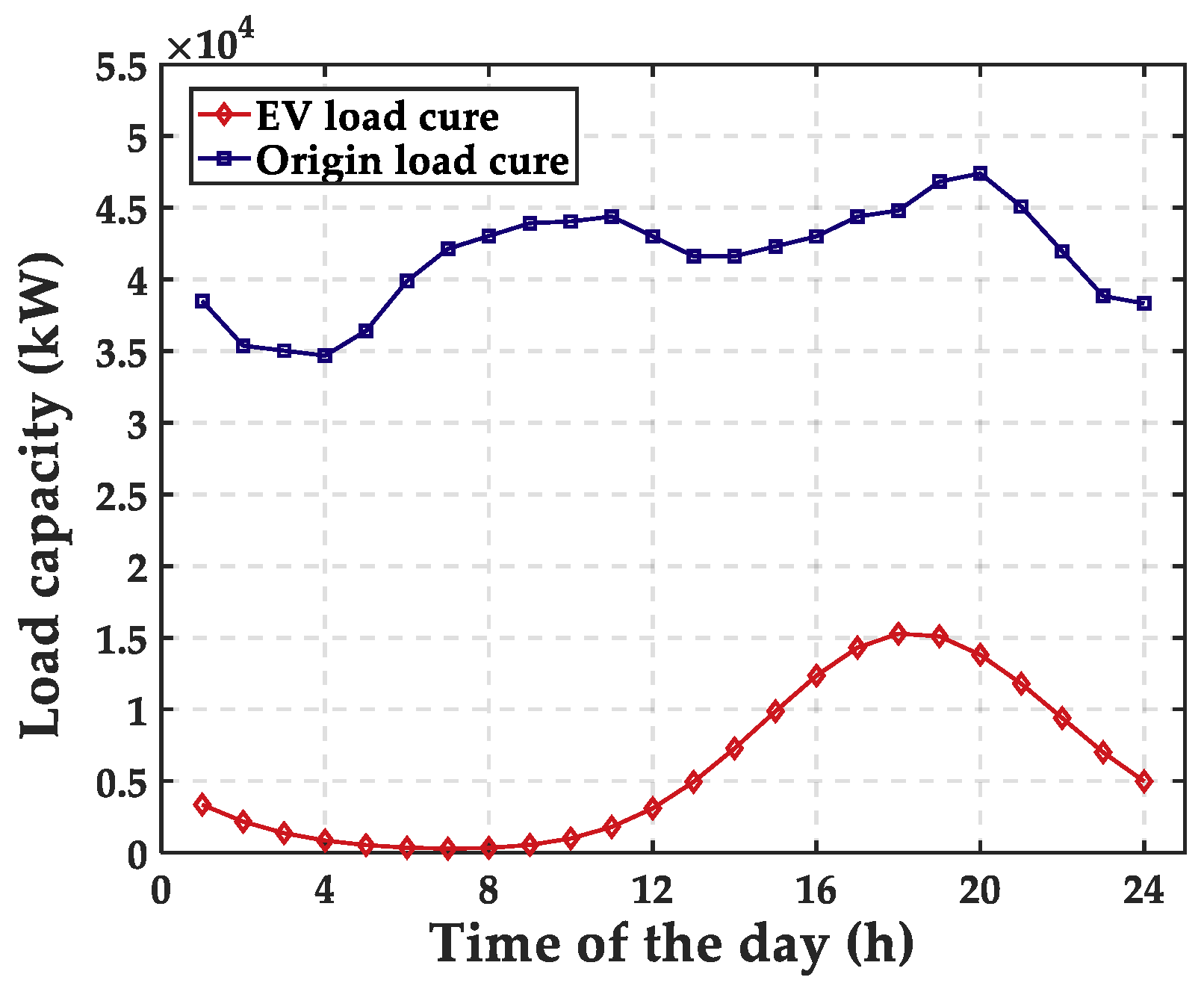An electric vehicle is driven by electric energy, which has the advantages of high efficiency and zero pollution. It can effectively reduce carbon emissions and is an essential means to solve traffic and environmental problems [
4]. Ref. [
5] pointed out that the cleanliness of electric vehicle charging sources directly determines whether the electric vehicle has low-carbon characteristics. As of 2021, coal-fired power generation (after this point referred to as thermal power) accounted for 61% of China’s electricity generation and has continued to dominate the energy structure of China’s power grid for a considerable period [
6]. Therefore, with adequate response measures, the cleanliness level of electric vehicle charging will be easier to ensure, and carbon emissions from the transportation end will only be transferred to the power generation side, contrary to the original intention of developing electric vehicles in China. After comparing the charging of electric vehicles under different grid energy structures in [
7], it was found that the level of clean electricity consumption of electric vehicles is significantly higher in areas with low thermal power ratios than in areas with high thermal power ratios. Ref. [
8] further pointed out that according to China’s current proportion of the power grid structure, if large-scale electric vehicles were directly connected to the grid for charging without control in the future, this would not be conducive to obtaining the expected environmental benefits. At the same time, coupling the inherent fluctuation and randomness of new energy output with the charging time of electric vehicles also poses particular challenges in the current power system [
9]. Therefore, it is necessary to realize the optimal scheduling of electric vehicle charging and clean energy by regulating the charging behavior of electric vehicles. Ref. [
10] aimed to minimize the operating costs of microgrids and studied the optimal energy management of clean energy and plug-in hybrid electric vehicles. In [
11], the authors proposed the optimal scheduling strategy for multi-microgrid and electric vehicle charging loads and realized the optimal distribution. Although [
10,
11] studied the optimal allocation of clean energy and electric vehicle load energy, they were both from the perspective of microgrids without considering the charging costs of electric vehicles. In [
12], the authors put forward an intelligent charging strategy for electric vehicles, which involved demand response from the perspective of electric vehicles and effectively reduced the charging costs of electric vehicle users. However, only the charging costs of electric vehicles was considered in the modeling process. Still, the carbon emissions from the power system caused by electric vehicle charging were not considered, which did not reflect the low-carbon attribute of electric vehicles. Ref. [
13] put forward a charging and discharging strategy for electric vehicles, which integrated the charging electricity price and the dynamic updating mechanism of carbon quota income and reduced the scheduling costs of users. However, considering the carbon quota of the whole life cycle of electric vehicles, it is not applicable to only consider the carbon emissions caused by the charging process of electric vehicles. In [
14], the authors defined the calculation method of carbon quota and carbon gain in the charging process of electric vehicles. The authors established a scheduling model considering the participation of electric vehicles in the carbon trading market. At the same time, the costs to users were reduced, and the carbon emission reduction performance of electric vehicles was fully exerted. However, when calculating the carbon emissions caused by the charging process of electric vehicles, this paper only used the proportion of thermal power generation to make a rough calculation, which needed more accuracy. Therefore, it is worth studying and discussing how to accurately calculate the power system’s carbon emissions caused by electric vehicles’ charging process and further explore the low-carbon properties of electric vehicles.
Ref. [
15] combined carbon emission analysis with power flow calculation for the first time and put forward the concept of carbon emission flow in power systems, which brought a new direction for the research of low-carbon power. In Ref. [
16], based on the theory of carbon emission flow in power systems, the similarities and differences between carbon emission flow and power flow calculation in power systems were further analyzed, and the primary calculation method of carbon emission flow in power systems was established. Refs. [
15,
16] measured and accounted for the carbon emissions of load power consumption from the power consumption side and improved the carbon emissions calculation method. As an effective tool to analyze low-carbon power, the theory of carbon emission flow has been thoroughly improved and developed. Based on the theory of carbon emission flow, the authors of Ref. [
17] studied the site selection and capacity planning issues of electric gas stations. The authors of Ref. [
18] designed a two-level low-carbon planning model of a power system considering carbon emission flow and demand response and adjusted the load distribution reasonably to reduce carbon emissions and carbon emission costs. The above work applied the carbon emission flow theory to the low-carbon research of power systems. However, there is limited work on the study of the carbon emissions when accounting for electric vehicle clusters’ charging load.
Considering the above issues, this paper presents a charging guidance strategy for electric vehicles based on power systems’ carbon emission flow theory. The carbon emissions caused by electric vehicle charging are accurately calculated using the carbon emission flow theory of power systems to guide and restrict the charging behavior of electric vehicles accurately. When calculating the carbon emission costs, the Shapley value carbon responsibility allocation method is introduced to calculate agents’ tiered carbon responsibility range in different locations to ensure fairness and rationality. Finally, the tiered carbon price is used as a signal to guide and encourage agents to arrange electric vehicle charging during the period of clean energy output to reduce the carbon emissions from power systems and the carbon emission costs paid by agents.
The rest of this paper is organized as follows:
Section 2 presents the charging load model of electric vehicles considering the energy consumption of temperature-responsive air conditioning;
Section 3 introduces the theory of carbon emission flow in a power system;
Section 4 presents the scope of tiered carbon responsibility for Shapley value calculation;
Section 5 introduces the low-carbon incentive guidance strategy model;
Section 6 presents the simulation results and analysis; and
Section 7 discusses the conclusions and prospects for future work.














